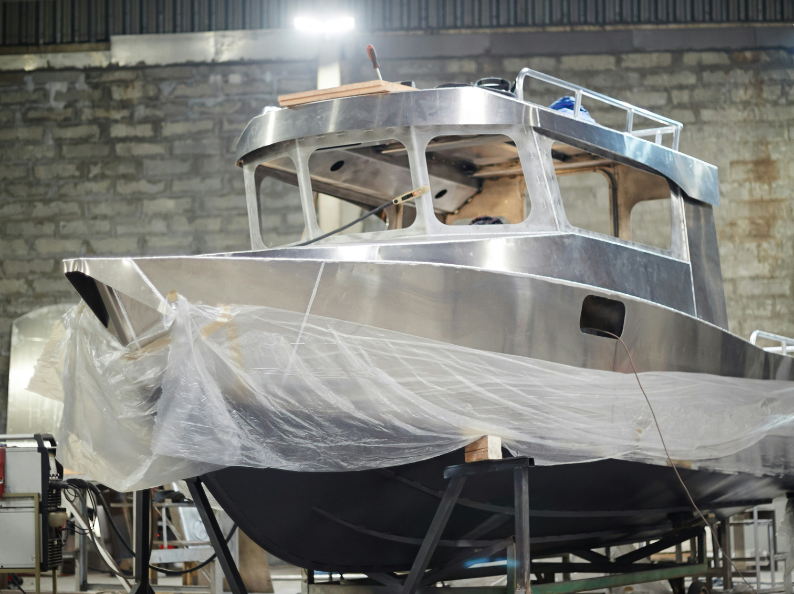Essential steps for effective boat repair: from evaluation to the shipyard

Repairing a boat shouldn’t be left to the last minute. Whether it’s after a busy sailing season or as part of preventive maintenance, acting in time can make the difference between a simple fix and a costly failure. In this article, we guide you step-by-step through the process of boat repair, from the initial evaluation to the final work in the shipyard, including a key step: the application of antifouling paint.
1. Initial assessment: spotting the unseen
Before repairing any vessel, the first essential step is a thorough inspection. This diagnosis helps you understand the actual condition of the boat and properly plan the necessary work. It’s advisable to involve a marine technician or surveyor who can identify structural faults that may go unnoticed by an untrained eye.
Key aspects to evaluate:
- Hull condition: cracks, osmosis, dents, deformations, paint loss or signs of corrosion.
- Mechanical systems: engine performance, oil leaks, compression levels, transmission, and propeller.
- Electrical systems: battery condition, connections, exposed wiring, lighting, and charging systems.
- Steering system: slack, component wear, response.
- Deck and joint watertightness: leaks, worn seals, water accumulation.
It’s best to conduct this inspection with the boat hauled out of the water in a professional shipyard, allowing full access to the areas below the waterline. Photos and a technical report are also helpful for documenting each issue.
Tip: If you notice loss of speed, increased fuel consumption, or vibrations, there may be damage to the hull, propeller, or shaft line.
2. Repair planning: materials, timing, and budget
Once the extent of the repairs is clear, a detailed action plan must be drawn up. This step is key to avoiding delays or cost overruns and allows for proper coordination between professionals involved.
This document should include:
- A prioritized task list.
- Choice of materials (epoxy resins, specific paints, original parts, etc.).
- Estimated time for each work section.
- Approximate cost per task and a margin for contingencies.
- Assignment of responsibility for each area.
If the repair includes structural elements, it’s important to consult a naval engineer to ensure safety and feasibility. For any new electrical or electronic systems, a compliance check with current regulations is also recommended.
3. Entering the shipyard: space, safety, and specialised equipment
The next step is to transport the vessel to the shipyard. This professional environment allows for safe, precise work and ensures compliance with safety and environmental regulations.
A quality shipyard in Barcelona, for example, will provide:
- Hydraulic cranes or travel lifts for hauling and launching.
- Cradles and supports to stabilise the hull.
- Paint booths or dedicated sanding zones with dust extraction.
- Ventilation systems and air compressors for pneumatic tools.
- Safe storage for flammable or hazardous materials.
Barcelona’s shipyards offer excellent conditions: direct access to the Mediterranean, mild weather year-round, and a strong network of skilled yacht repair technicians.
4. Structural and mechanical repairs
With the boat secured on dry land, repair work can begin. These tasks may range from sealing a small crack to replacing entire propulsion components.
Hull and structure
- Osmosis repair through drying, grinding, and epoxy resins.
- Reinforcement of weakened areas using fiberglass or composite materials.
- Replacement or repair of aluminium plates, laminated wood, or polyester sections.
Propulsion system
- Propeller replacement for quieter or more efficient models.
- Shaft alignment, shaft bearing and seal inspection.
- Cleaning and tuning of the cooling system, filter replacement, spark plug checks.
Electrical and electronics
- Replacement of corroded wiring, waterproof connectors, grounding.
- Installation or upgrading of GPS, AIS, radar, and electrical panels.
- Full check of the energy distribution and battery charging systems.
Each task requires technical knowledge and must be done following manufacturer specifications and industry regulations.
5. Applying antifouling paint: protection and efficiency
One of the most important, and often underestimated, steps is applying antifouling. This special paint prevents marine organisms like algae and barnacles from sticking to the hull—improving speed and reducing fuel consumption.
Application process:
- Sanding or stripping the old antifouling, preserving structural layers.
- Pressure washing and full drying of the hull.
- Applying primer or epoxy barrier if required.
- Rolling or spraying antifouling paint in multiple coats, based on product type.
Types of antifouling:
- Self-polishing: wears off gradually with water movement—ideal for frequently used boats.
- Hard: more durable, suited for racing yachts or high-speed boats.
- Eco-friendly: no biocides, recommended for protected areas or eco-conscious users.
Note: Your antifouling choice should match your boat’s usage, sailing area, and haul-out frequency. Hull material and compatibility with other coatings also matter.
6. Final checks and sea trial
Before returning to the water, a full check is essential to ensure everything functions properly. This is one of the most important phases, as it helps catch last-minute issues and fine-tune systems before regular sailing begins.
Basic checklist:
- Hull watertightness (visual check or pressure test).
- Dry test of the engine: startup, smoke output, unusual noises.
- Full system check: electrics, batteries, navigation aids.
- Antifouling inspection: coverage, edges, missed spots.
- Safety gear on board: flare expiration dates, fire extinguisher levels, bilge pump operation, life jackets, emergency lighting.
A short sea trial of at least an hour is strongly recommended. It helps assess steering, vibration, fuel consumption, and the overall response of the systems. If major changes were made, bring a technician on board to monitor the results.
Timely repairs mean peace of mind at sea
An effective yacht repair doesn’t begin with a breakdown—it starts with proper planning. From the first assessment to antifouling application and sea trials, each step ensures your boat is safe, efficient, and ready to sail.
At Barcelona Nautic Center, we have the facilities and expert team to support you through the entire yacht repair process. Contact us today to ensure your vessel gets the professional care it deserves—just in time for the season.


